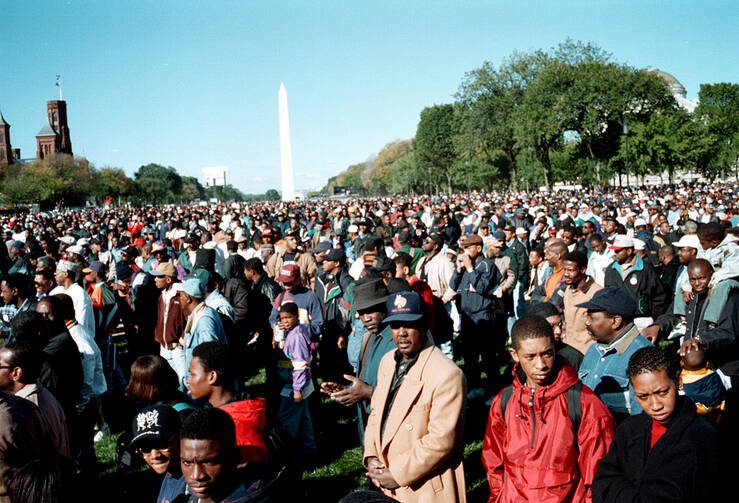October 16, 2015 marked the 20th anniversary of the Million Man March. This editorial was originally published in the November 4, 1995 issue of America.
The U.S. Constitution was written, says its first sentence, so that the people of the United States might form a more perfect union. On a single day last month, that aspiration received two boosts. At the University of Texas in Austin, Bill Clinton gave the best speech yet made by an American President on the improvement of relationships between black and white citizens. On that same Oct. 16, more than 400,000 African-American men came together on the Mall in Washington, D.C., for what was called a march. In its peaceful and exuberant idealism, that gathering was more like a religious rally than a political demonstration.
To be sure, some speakers at the march emphasized the evils of racism, but that was no more than the President did in Austin. Both participants and media observers agreed, however, that the rally’s main theme was its call to black men to take responsibility for their actions, their families, their neighborhoods and their country.
For its admirable coverage of this momentous event, The Washington Post sent to the Mall not only reporters but also pollsters, who found that this was largely a crowd of middle-class men reaffirming commitments they had already made.
Jack Tilson, music director at the Catholic parish of Sts. Peter and Paul in Decatur, Ga., told a Catholic News Service reporter: “The Scriptures tell us, ‘Am I my brother’s keeper?’ And the answer is a resounding yes. I cannot separate myself from those who are irresponsible. We’ve got to help them.”
A 15-year-old from New York City, Mtume Gant, pointed to the wider significance of the rally when, responding to a Washington Post inquirer, he said: “This is not just about black people. It’s about the betterment of American society.”
It was inevitable that there were some dissenters looking on. The march was criticized because it excluded black women, but that complaint was perverse because the rally aimed explicitly at the bonding of black men. As Dorothy Height, the veteran leader of the National Council of Negro Women, said when she spoke on the Mall, much that is negative has been reported about young black men—for instance that one out of three is somewhere in the correctional system. But that means, as Miss Height noted, that two out of three are not in that system. The rally reinforced the hopes of those latter young men.
The main doubts about the march centered on its prime mover, the enigmatic Minister Louis Farrakhan, leader of the shadowy Nation of Islam movement. Besides being a powerful speaker and a highly effective organizer, Mr. Farrakhan is also an unabashed racist demagogue and anti-Semite.
In an Op-Ed piece in the Oct. l 7 issue of The Washington Post, one of the most eminent of older African-Americans, A. Leon Higginbotham Jr., a former Federal chief judge, wrote that he had not attended the rally because he could not separate its message of hope “from some of the dialogue of the predominant messenger, Mr. Farrakhan.”
Those who assembled on the Mall were able to make the distinction—and why not? On the MacNeil/Lehrer NewsHour that evening, Charlayne Hunter-Gault reported that many in the crowd said the rally was bigger than any one person. It is indeed wrong to cooperate with Mr. Farrakhan when he talks or acts dangerously. But when he recommends, as he did in his rambling two-hour speech at the rally, that black men shoulder their responsibilities, register and vote and join some local church, synagogue, temple or mosque, this good advice can be seconded even by those who doubt the speaker's sincerity.
What matters now, as commentators from President Clinton to Minister Farrakhan agree, is the follow-up. Hugh Price, president of the National Urban League and a panelist on the MacNeil/Lehrer program’s discussion of the march, put it this way: “The proof will be in whether we organize, mobilize and assume responsibility to press toward full participation in the mainstream of American life.”
Yet even if the results should be slight, the march will remain a historic achievement. Like the black-led civil rights demonstrations of the l 960s, and unlike the whiteled Vietnam War protests, this rally was distinguished by unaffected appeals to religious conviction and feeling. In truth, the ideal of brotherhood inspiriting the marchers is most fully understood within a biblical perspective.
Forty years ago, the moral theologian Gerald Kelly, S.J., (1902-64) argued against racial segregation precisely from this viewpoint of faith. The dignity of the human personality possessed by each individual, calls for a basic equality. The human nature and ultimate destiny shared by all call for union. Racial discrimination violates equality. Racial segregation, even the voluntary apartheid advocated by Louis Farrakhan, violates union. Bill Clinton in Texas and the multitude on the Mall should be a reminder to the nation that it has come a good distance in its journey toward equality and unity and should serve as an inspiration for traveling the rest of the way.








